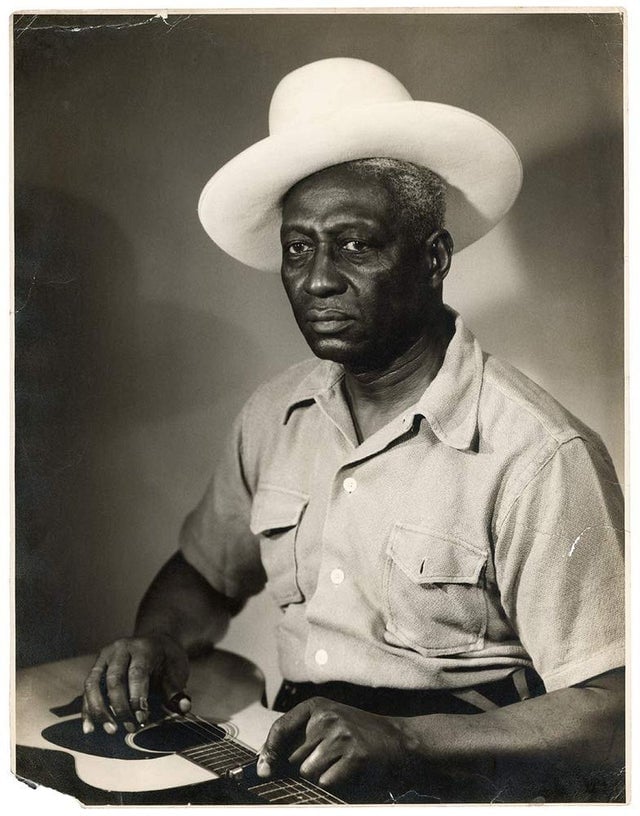Just 22 years before my matriculation at the University of Texas, a concert was given on campus that did not draw a lot of attention. It was summertime, June 15, 1949, to be specific, and most of the students were away. Appearing that night was one man with a 12-string guitar. His name was Huddie Ledbetter, more commonly known as Lead Belly (sometimes spelled “Leadbelly”). With a repertoire of somewhere between 500 and 1,000 songs, many of which he wrote himself or at least popularized, he had long been acknowledged as a musical giant. Walking out on stage uneasily and sounding a bit weak, Lead Belly nonetheless had the crowd at Hogg Auditorium in his hand. He concluded the show with his most famous song, “Good Night, Irene.” Ledbetter’s concert at UT was one of the last times he played in public because he had already been diagnosed with Lou Gehrig’s disease and would be dead before the year was out.
He had been born in the late 1880s—the exact year is uncertain—in a remote part of northwestern Louisiana. Short and stout, Ledbetter distinguished himself in three ways: an ability to work hard (he could pick 500 pounds of cotton in a day), an insatiable appetite for women and musical talent. A fourth trait that can hardly be ignored is violence. He was raised in a frontier area where fistfights, stabbings and shootings were not at all rare, and the code of honor ruled. Ledbetter was not afraid to tangle, which led to four periods of incarceration. He was convicted of illegal possession of a gun and did time on a chain gang in Harrison County, Texas in 1915 before escaping and living under the alias “Walter Boyd.” He spent seven years in the Texas penal system for murder, another four or so at the notorious Angola Prison in Louisiana (for intent to kill) and a few months in the clink in New York City (for felonious assault). Lead Belly was a rough and tough man, and that’s a natural fact.
As indicated earlier, however, he had unusual prowess as a singer and on the guitar, mandolin, accordion and piano. When not behind bars, Lead Belly played in sukey jumps, roadhouses, bordellos, juke joints, dance halls and saloons in rural areas of Louisiana and Texas, as well as Fannin Street in Shreveport, Deep Ellum in Dallas (where he formed a duo of sorts with Blind Lemon Jefferson) and Bourbon Street in New Orleans. He played country blues and folk songs that had been handed down from previous generations. Music was part of life in prison, and he honed his skills there as well. He sometimes suffered the overseer’s lash during those terrible times but came out alive. The Lead Belly sobriquet was given to him while in Angola.
After a fortuitous meeting with father-and-son folksong collectors John A. and Alan Lomax in 1933, Lead Belly shed his striped prison uniform and was quickly on the way to acceptance, approval and heartfelt admiration from levels of society with which he had no previous contact or of which he had not even been aware. An impromptu concert before the scholars of the Modern Language Association in Philadelphia in December 1934 really shone the spotlight on Ledbetter, followed by more such gatherings at Harvard and other colleges in New England, and the Midwest.
In the 1940s, Lead Belly was the leader of an American folk music revival. Woody Guthrie, Pete Seeger, Cisco Houston, Josh White and others deferred to him not just for his ability to sing and play the guitar but for the hard, in some ways heroic, life he had lived. Many times he appeared before left-wing gatherings although he was not politically minded. The one exception was civil rights; Lead Belly had dealt with Jim Crow injustice and did all he could to counter it.
That brings us back to the Hogg Auditorium concert given by a sickly Ledbetter in the summer of 1949. The University of Texas administration was then battling in the courts to prevent a black man named Heman Sweatt from entering its law school. He prevailed, and thus began my alma mater’s painful and halting integration process. The folkies used to sing that change was coming, and it sure came to Austin.


5 Comments
I have the CD recording of this concert. It’s one of my most played CDs. The sleeve has a quite detailed biography.
OK, how about the article I wrote?
great article. My uncle is the late Lead Belly and I didnt know the auditorium was built in 1933. Great article but the violence part is not something uncle Huddie glorified. my grandmother Tiny Robinson educated people for many years and even accepted his Lifetime award for the Rock and Roll HAll of fame. The early days were lawless and discrimination was very real for black men in american in early 20th century.
Was the CActus café not hosting performances in 1949?
Not sure, but that is a tiny venue….Hogg Auditorium bigger and more dignified.
Add Comment